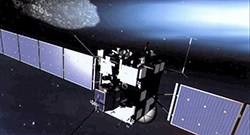Rosetta set to reveal whether water and life were brought to Earth by comets

The Finnish Meteorological Institute (FMI) is a strong player in the European Space Association's (ESA) Rosetta Mission. Rosetta is currently en route to the Churyumov-Gerasimenko comet. Rosetta's lander is scheduled to land on the comet's surface on 11 November 2014.
The FMI has participated in the design and manufacture of the five scientific measurement instruments that the Rosetta probe is carrying. By European standard's, the FMI's role in this project is therefore a very significant one. The first instrument to land on the comet will be the FMI-manufactured PP instrument, which is attached to the lander's legs. The instrument will be used to search for water on the surface of the comet. If water, which has the same isotopic composition as that found in the Earth's oceans, is found on the comet's surface, this will demonstrate that water, which has enabled life to form on Earth, has arrived on Earth at least partly on comets. FMI-made measurement instruments will also be used to study such things as the comet's dust and the comet's interaction with solar wind. If organic matter is found in the dust, it is possible that life was also brought to Earth by comets.
The space probe was named after the Rosetta Stone found in Egypt and the Philae lander after the location at which the obelisk was found. The two language text (Egyptian and Greek) on the Rosetta Stone made it possible to decipher hieroglyphs. Researchers hope that the Rosetta probe will, in a similar way, provide information on the birth of the solar system and the origin of water and life. "All this data would be ground breaking. On the other hand, we must keep in mind what an infinitely difficult project is in question, as we know very little about comets. In practice, we do not even know what a comet's surface is like; it could be covered by ice or a more cotton candy-like material, which means the project is exceptionally difficult to carry out," notes FMI Research Manager Walter Schmidt.
Due to lack of information, researchers have had to take every possible option into account when planning the landing stage. The over ten year journey and orientation towards the comet have also required planning and technology of unprecedented magnitude. Plans were further complicated by launch problems experienced by the Ariane rocket, which saw researchers lose the opportunity to study the original research destination, the smaller 46P/Wirtanen comet.
Rosetta will be woken up on 20 January
One of most exciting moments of the project will take place on 20 January around 7.30 pm – 8.30 pm Finnish time. Rosetta will re-establish communication with Earth for the first time after 1 ½ years of slumber. In order to conserve energy, Rosetta was put in deep space hibernation for its journey to the comet. Rosetta's spinning motion will stop during the waking process, and the probe will recognise its location according to its own star cart. After this, the probe will turn its solar panels towards the sun and its antennae towards Earth, so that the probe can receive a signal.
"Successful reception of the signal from Earth will mean that we are one step closer to successful completion of the project. This is all extremely exciting for our research team, which has worked on the project for over ten years already," says FMI Research Manager Walter Schmidt. If Rosetta awakes in the next ten days, it will little by little begin to test its instruments and start it approach towards the Churyumov-Gerasimenko comet.
Further information:
Research Manager Walter Schmidt, tel. +358 29 539 4658, walter.schmidt@fmi.fi
http://www.esa.int/spaceinvideos/Missions/Rosetta
FMI's Rosetta webpage: http://space.fmi.fi/index.php?id=rosetta
Rosetta is an ESA mission with contributions from its member states and NASA. Rosetta's Philae lander is provided by a consortium led by DLR, MPS, CNES and ASI. Rosetta will be the first mission in history to rendezvous with a comet, escort it as it orbits the Sun, and deploy a lander to its surface. Comets are time capsules containing primitive material left over from the epoch when the Sun and its planets formed. By studying the gas, dust, and organic materials associated with the comet, via both remote and in-situ observations, the Rosetta mission should become the key to unlocking the history and evolution of our Solar System, as well as answering questions regarding the origin of Earth's water and perhaps even life.
